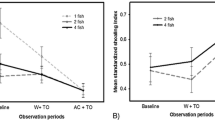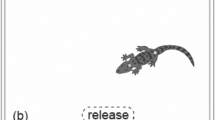Abstract
Learning can occur through self-experience with the environment, or through the observation of others. The latter allows for adaptive behaviour without trial-and-error, thus maximizing individual fitness. Perhaps given their mostly solitary lifestyle, cuttlefish have seldomly been tested under observational learning scenarios. Here we used a multi-treatment design to disentangle if and how neurally immature cuttlefish Sepia officinalis hatchlings (up to 5 days) incorporate social information into their decision-making, when performing a task where inhibition of predatory behaviour is learned. In the classical social learning treatment using pre-trained demonstrators, observers did not register any predatory behaviour. In the inhibition by social learning treatment, using naïve (or sham) demonstrators, more observers than demonstrators learned the task, while also reaching learning criterion in fewer trials, and performing less number of attacks per trial. Moreover, the performance of demonstrator–observer pairs was highly correlated, indicating that the mere presence of conspecifics did not explain our results by itself. Additionally, observers always reported higher latency time to attack during trials, a trend that was reversed in the positive controls. Lastly, pre-exposure to the stimulus did not improve learning rates. Our findings reveal the vicarious capacity of these invertebrate newborns to learn modulation (inhibition) of predatory behaviour, potentially through emulation (i.e. affordance learning). Despite ongoing changes on neural organization during early ontogeny, cognitively demanding forms of learning are already present in cuttlefish newborns, facilitating behavioural adaptation at a critical life stage, and potentially improving individual fitness in the environment.



Similar content being viewed by others
References
Agin V, Chichery R, Chichery M (2001) Effects of learning on cytochrome oxidase activity in cuttlefish brain. NeuroReport 12:113–116
Agin V, Chichery R, Dickel L, Chichery M-P (2006) The “prawn-in-the-tube” procedure in the cuttlefish: habituation or passive avoidance learning? Learn Mem 13:97–101. https://doi.org/10.1101/lm.90106
Albertin CB, Simakov O, Mitros T et al (2015) The octopus genome and the evolution of cephalopod neural and morphological novelties. Nature 524:220–224. https://doi.org/10.1038/nature14668
Amodio P, Boeckle M, Schnell AK et al (2018) Grow smart and die young: why did cephalopods evolve intelligence? Trends Ecol Evol 34:45–56. https://doi.org/10.1016/j.tree.2018.10.010
Biederman GB, Davey VA, Suboski MD et al (1993) Social learning in invertebrates. Science 259:1627–1629
Boal JG (1996) Absence of social recognition in laboratory-reared cuttlefish, Sepia officinalis L. (Mollusca: Cephalopoda). Anim Behav 52:529–537. https://doi.org/10.1006/anbe.1996.0195
Boal JG (2006) Social recognition: a top down view of cephalopod behaviour. Vie milieu Life Environ 56:69–79
Boal JG, Hylton RA, Gonzalez SA, Hanlon RT (1999) Effects of Crowding on the Social Behavior of Cuttlefish (Sepia officinalis). Contemp Top Lab Anim Sci 38:49–55. https://doi.org/10.1111/j.1469-7998.1994.tb08582.x
Boal JG, Wittenberg KM, Hanlon RT (2000) Observational learning does not explain improvement in predation tactics by cuttlefish (Mollusca: Cephalopoda). Behav Processes 52:141–153. https://doi.org/10.1016/S0376-6357(00)00137-6
Cartron L, Darmaillacq AS, Dickel L (2013) The “prawn-in-the-tube” procedure: what do cuttlefish learn and memorize? Behav Brain Res 240:29–32. https://doi.org/10.1016/j.bbr.2012.11.010
Darmaillacq AS, Lesimple C, Dickel L (2008) Embryonic visual learning in the cuttlefish, Sepia officinalis. Anim Behav. https://doi.org/10.1016/j.anbehav.2008.02.006
Darmaillacq AS, Dickel L, Mather J (2014) Cephalopod cognition. Cambridge University Press, Cambridge
Dickel L, Chichery M-P, Chichery R (1997) Postembryonic maturation of the vertical lobe complex and early development of predatory behavior in the cuttlefish (Sepia officinalis). Neurobiol Learn Mem 67:150–160
Edsinger E, Dölen G (2018) A conserved role for serotonergic neurotransmission in mediating social behavior in octopus. Curr Biol. https://doi.org/10.1016/j.cub.2018.07.061
Fiorito G, Scotto P (1992) Observational learning in Octopus vulgaris. Science 256:545–547
Galef BG, Laland KN (2005) Social learning in animals : empirical studies and theoretical models. Bioscience 55:489–499
Guibé M, Poirel N, Houdé O, Dickel L (2012) Food imprinting and visual generalization in embryos and newly hatched cuttlefish, Sepia officinalis. Anim Behav. https://doi.org/10.1016/j.anbehav.2012.04.035
Hanlon RT, Messenger JB (1988) Adaptive coloration in young cuttlefish (Sepia officinalis L.): the morphology and development of body patterns and their relation to behaviour. Philos Trans R Soc London B 320:437–487
Heyes CM (1994) Social learning in animals: categories and mechanisms. Biol Rev 69:207–231. https://doi.org/10.1111/j.1469-185X.1994.tb01506.x
Heyes C (2012) What’s social about social learning? J Comp Psychol 126:193–202. https://doi.org/10.1037/a0025180
Hochner B (2008) Octopuses. Curr Biol 18:R897–R898. https://doi.org/10.1016/j.cub.2008.07.057
Huang KL, Chiao CC (2013) Can cuttlefish learn by observing others? Anim Cogn 16:313–320. https://doi.org/10.1007/s10071-012-0573-z
Jozet-Alves C, Bertin M, Clayton NS (2013) Evidence of episodic-like memory in cuttlefish. Curr Biol 23:R1033–R1035. https://doi.org/10.1016/j.cub.2013.10.021
Klein ED, Zentall TR (2003) Imitation and affordance learning by pigeons (Columba livia). J Comp Psychol 117:414–419. https://doi.org/10.1037/0735-7036.117.4.414
Liscovitch-Brauer N, Alon S, Porath HT et al (2017) Trade-off between transcriptome plasticity and genome evolution in cephalopods. Cell 169:191–202. https://doi.org/10.1016/j.cell.2017.03.025
Liu Y-C, Liu T-H, Su C-H, Chiao C-C (2017) Neural organization of the optic lobe changes steadily from late embryonic stage to adulthood in cuttlefish Sepia pharaonis. Front Physiol 8:1–16. https://doi.org/10.3389/fphys.2017.00538
Messenger JB (1973) Learning in the cuttlefish, Sepia. Anim Behav 21:801–826. https://doi.org/10.1016/S0003-3472(73)80107-1
Nixon M, Mangold K (1998) The early life of Sepia officinalis, and the contrast with that of octopus vulgaris (Cephalopoda). J Zool. https://doi.org/10.1017/S0952836998008048
Olmstead MC, Kuhlmeier VA (2015) Learning from others. In: Olmstead MC, Kuhlmeier VA (eds) Comparative cognition. Cambridge University Press, Cambridge, pp 391–417
Purdy JE, Peters A, Riedlinger E, Suarez R (2006) Prawn-in-a-tube procedure: habituation or associative learning in cuttlefish? J Gen Psychol 133:131–152
R Core Team (2018) R: a language and environment for statistical computing. R Foundation for Statistical Computing, Vienna, Austria. http://www.R-project.org/
Schnell AK, Clayton NS (2019) Cephalopod cognition. Curr Biol 29:R715–R737. https://doi.org/10.1017/CBO9781139058964
Shettleworth SJ (2001) Animal cognition and animal behaviour. Anim Behav 61:277–286. https://doi.org/10.1006/anbe.2000.1606
Shomrat T, Zarrella I, Fiorito G, Hochner B (2008) The octopus vertical lobe modulates short-term learning rate and uses LTP to acquire long-term memory. Curr Biol 18:337–342
Vila Pouca C, Heinrich D, Huveneers C, Brown C (2020) Social learning in solitary juvenile sharks. Anim Behav 159:21–27. https://doi.org/10.1016/j.anbehav.2019.10.017
Yasumuro H, Nakatsuru S, Ikeda Y (2015) Cuttlefish can school in the field. Mar Biol. https://doi.org/10.1007/s00227-015-2622-z
Acknowledgements
We thank Catarina Santos, Maria Rita Pegado, and Marta Pimentel for cuttlefish rearing.
Funding
Research funded by MARE strategic project (UID/MAR/04292/2019), MAR2020 project VALPRAD (MAR-01.04.02-FEAMP-0007), the Portuguese Foundation for Science and Technology (FCT): as PhD (ES, SFRH/BD/131771/2017), Postdoc (VML, PTDC/BIA-BMA/28317/2017) grants, and the DFG Centre of Excellence 2117 “Centre for the Advanced Study of Collective Behaviour” (ID: 422037984).
Author information
Authors and Affiliations
Contributions
ES, VM, and RR conceived the study. ES, VM, CSR, BBLM, BM, AML, and EM reared animals, performed the experiment, and collected the data. ES and CSR analysed the data. All authors contributed to the manuscript, agree to be held accountable for the content therein, and approved the final version of the manuscript.
Corresponding author
Ethics declarations
Conflict of interest
The authors declare no conflict of interest.
Ethics approval
Research was conducted under approval of Faculdade de Ciências da Universidade de Lisboa animal welfare body (ORBEA) and Direção-Geral de Alimentação e Veterinária (DGAV), within the framework of project VALPRAD (MAR-01.04.02-FEAMP-0007), in accordance with the requirements imposed by the Directive 2010/63/EU of the European Parliament and of the Council of 22 September 2010 on the protection of animals used for scientific purposes.
Code availability
R code used is provided as Supplemental Material.
Additional information
Publisher's Note
Springer Nature remains neutral with regard to jurisdictional claims in published maps and institutional affiliations.
Electronic supplementary material
Below is the link to the electronic supplementary material.
Rights and permissions
About this article
Cite this article
Sampaio, E., Ramos, C.S., Bernardino, B.L.M. et al. Neurally underdeveloped cuttlefish newborns exhibit social learning. Anim Cogn 24, 23–32 (2021). https://doi.org/10.1007/s10071-020-01411-1
Received:
Revised:
Accepted:
Published:
Issue Date:
DOI: https://doi.org/10.1007/s10071-020-01411-1




